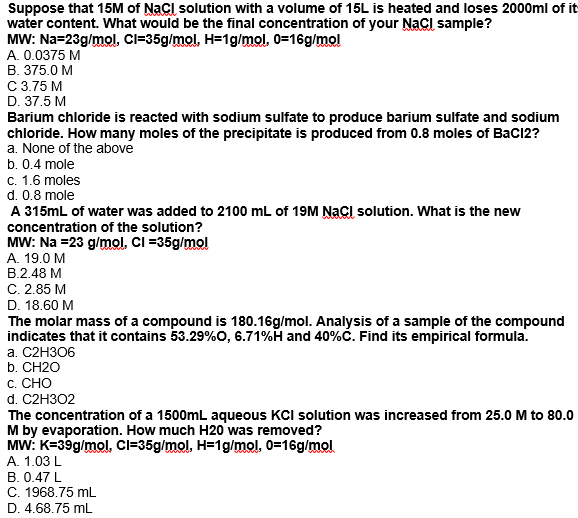Suppose that 15M of Naci solution with a volume of 15L is heated and loses 2000ml of water content. What would be the final concentration of your Nacl sample? MW: Na=23g/mol, CI=35g/mol, H=1g/mol, 0=16g/mol A. 0.0375 M В. 375.0 М C 3.75 M D. 37.5 M Barium chloride is reacted with sodium sulfate to produce barium sulfate and sodium chloride. How many moles of the precipitate is produced from 0.8 moles of Bac12? a. None of the above b. 0.4 mole C. 1.6 moles d. 0.8 mole A 315mL of water was added to 2100 mL of 19M NacI solution. What is the new concentration of the solution? MW: Na =23 g/mol, CI =35g/mol А. 19.0 М В 248 М C. 2.85 M D. 18.60 M The molar mass of a compound is 180.16g/mol. Analysis of a sample of the compound indicates that it contains 53.29%0, 6.71%H and 40%ć. Find its empirical formula. а. С2НЗО6 b. CH2O с. СнО d. C2H302 The concentration of a 1500mL aqueous KCI solution was increased from 25.0 M to 80. M by evaporation. How much H20 was removed? MW: K=39g/mol, CI=35g/mol, H=1g/mol, 0=16g/mol A. 1.03 L B. 0.47 L C. 1968.75 mL D. 4.68.75 mL
Suppose that 15M of Naci solution with a volume of 15L is heated and loses 2000ml of water content. What would be the final concentration of your Nacl sample? MW: Na=23g/mol, CI=35g/mol, H=1g/mol, 0=16g/mol A. 0.0375 M В. 375.0 М C 3.75 M D. 37.5 M Barium chloride is reacted with sodium sulfate to produce barium sulfate and sodium chloride. How many moles of the precipitate is produced from 0.8 moles of Bac12? a. None of the above b. 0.4 mole C. 1.6 moles d. 0.8 mole A 315mL of water was added to 2100 mL of 19M NacI solution. What is the new concentration of the solution? MW: Na =23 g/mol, CI =35g/mol А. 19.0 М В 248 М C. 2.85 M D. 18.60 M The molar mass of a compound is 180.16g/mol. Analysis of a sample of the compound indicates that it contains 53.29%0, 6.71%H and 40%ć. Find its empirical formula. а. С2НЗО6 b. CH2O с. СнО d. C2H302 The concentration of a 1500mL aqueous KCI solution was increased from 25.0 M to 80. M by evaporation. How much H20 was removed? MW: K=39g/mol, CI=35g/mol, H=1g/mol, 0=16g/mol A. 1.03 L B. 0.47 L C. 1968.75 mL D. 4.68.75 mL
Chemistry & Chemical Reactivity
9th Edition
ISBN:9781133949640
Author:John C. Kotz, Paul M. Treichel, John Townsend, David Treichel
Publisher:John C. Kotz, Paul M. Treichel, John Townsend, David Treichel
Chapter13: Solutions And Their Behavior
Section: Chapter Questions
Problem 57GQ: Dimethylglyoxime [DMG, (CH3CNOH)2] is used as a reagent to precipitate nickel ion. Assume that 53.0...
Related questions
Question

Transcribed Image Text:Suppose that 15M of NaCi solution with a volume of 15L is heated and loses 2000ml of it
water content. What would be the final concentration of your Nacl sample?
MW: Na=23g/mol, CI=35g/mol, H=1g/mol, 0=16g/mol
A. 0.0375 M
В. 375.0 М
C 3.75 M
D. 37.5 M
Barium chloride is reacted with sodium sulfate to produce barium sulfate and sodium
chloride. How many moles of the precipitate is produced from 0.8 moles of Bac12?
a. None of the above
b. 0.4 mole
C. 1.6 moles
d. 0.8 mole
A 315mL of water was added to 2100 mL of 19M Naci solution. What is the new
concentration of the solution?
MW: Na =23 g/mol, CI =35g/mol
А. 19.0 М
В 248 М
C. 2.85 M
D. 18.60 M
The molar mass of a compound is 180.16g/mol. Analysis of a sample of the compound
indicates that it contains 53.29%0, 6.71%H and 40%ć. Find its empirical formula.
а. С2НЗО6
b. CH2O
с. СнО
d. C2H302
The concentration of a 1500mL aqueous KCI solution was increased from 25.0 M to 80.0
M by evaporation. How much H20 was removed?
MW: K=39g/mol, CI=35g/mol, H=1g/mol, 0=16g/mol
A. 1.03 L
B. 0.47 L
C. 1968.75 mL
D. 4.68.75 mL
Expert Solution
This question has been solved!
Explore an expertly crafted, step-by-step solution for a thorough understanding of key concepts.
Step by step
Solved in 2 steps

Knowledge Booster
Learn more about
Need a deep-dive on the concept behind this application? Look no further. Learn more about this topic, chemistry and related others by exploring similar questions and additional content below.Recommended textbooks for you

Chemistry & Chemical Reactivity
Chemistry
ISBN:
9781133949640
Author:
John C. Kotz, Paul M. Treichel, John Townsend, David Treichel
Publisher:
Cengage Learning

Chemistry & Chemical Reactivity
Chemistry
ISBN:
9781337399074
Author:
John C. Kotz, Paul M. Treichel, John Townsend, David Treichel
Publisher:
Cengage Learning


Chemistry & Chemical Reactivity
Chemistry
ISBN:
9781133949640
Author:
John C. Kotz, Paul M. Treichel, John Townsend, David Treichel
Publisher:
Cengage Learning

Chemistry & Chemical Reactivity
Chemistry
ISBN:
9781337399074
Author:
John C. Kotz, Paul M. Treichel, John Townsend, David Treichel
Publisher:
Cengage Learning



Chemistry
Chemistry
ISBN:
9781305957404
Author:
Steven S. Zumdahl, Susan A. Zumdahl, Donald J. DeCoste
Publisher:
Cengage Learning

Chemistry: An Atoms First Approach
Chemistry
ISBN:
9781305079243
Author:
Steven S. Zumdahl, Susan A. Zumdahl
Publisher:
Cengage Learning